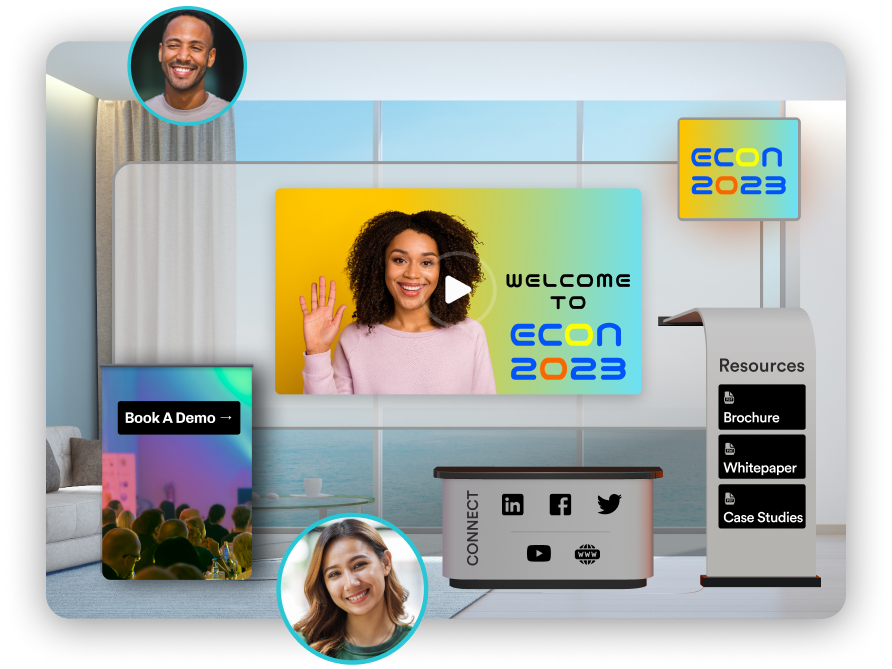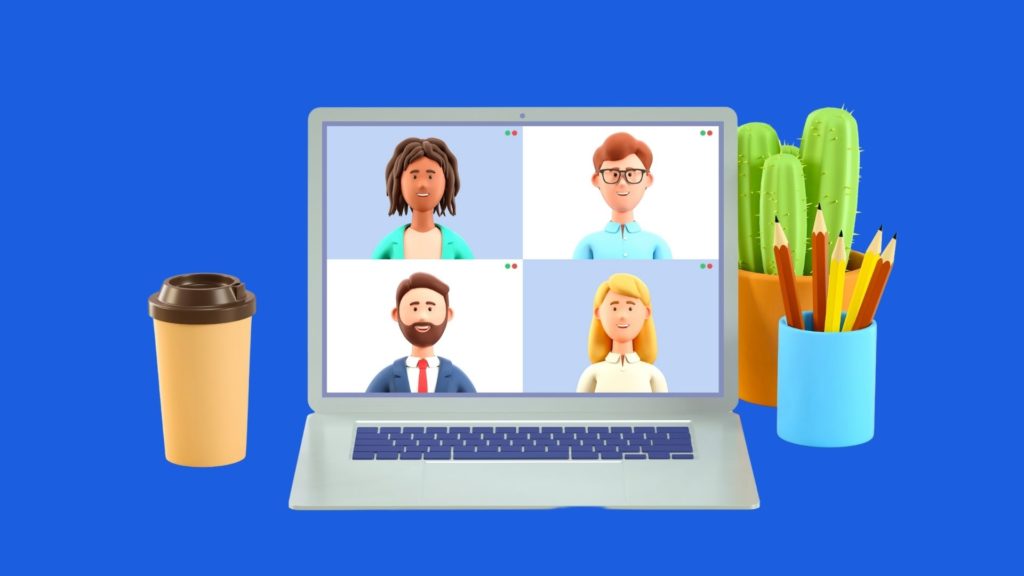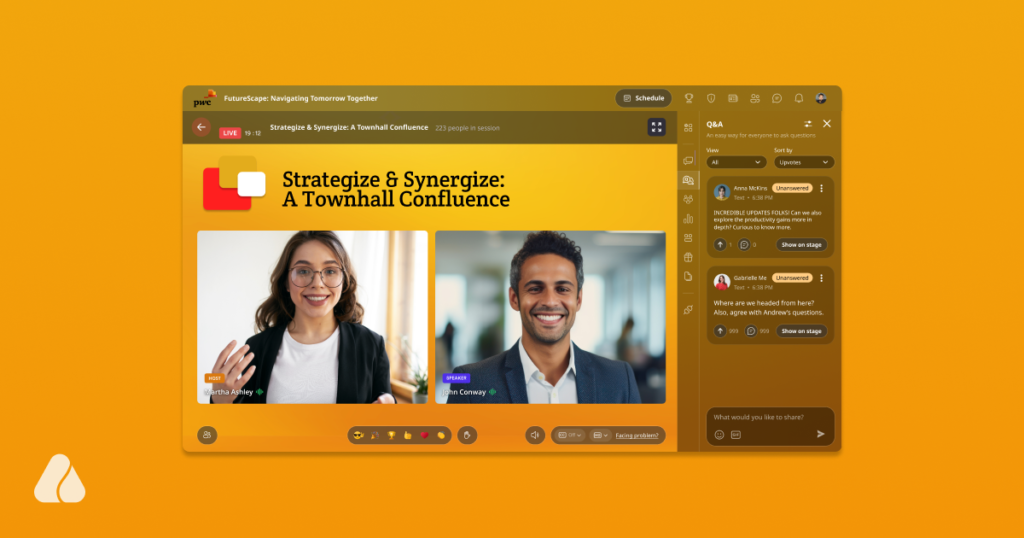What do people want from a virtual trade show? There are two facets to consider: The attendee experience and the exhibitor experience. That means virtual trade show hosts need to be skilled in planning an event that gives everybody value—and that they are able to maximize the features of a virtual event platform to create human moments and optimize networking opportunities.
An unforgettable virtual trade fair forms connections. It also:
- Captures attention
- Engages using demos and speakers
- Seamlessly shares information
- Offer flexible areas for people to interact
In addition, dynamic online trade shows use virtual event platforms that give event organizers innovative tools and cutting-edge features. They’re able to harness today’s technology to design powerful experiences.
When you host a virtual trade show, you need to know the steps, best practices, and virtual platform you need to design an outstanding event. This guide will give you everything you need for an effective and memorable virtual trade show.
So, let’s begin!
What are virtual trade shows?
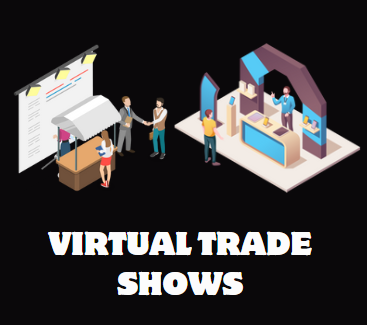
Virtual trade shows are a type of online event where companies showcase their products and services to the audience they are targeting. The core objective of an online trade show event is to provide businesses with a platform to showcase their offering to interested leads and make potential business deals.
Virtual events allow organizations to connect and reach a worldwide audience, eliminating geographical barriers, as well as network with industry leaders, unlike an in-person trade show. Such online exhibition events typically feature virtual booths, live presentations, networking lounges, interactive features, and more, creating an engaging experience for exhibitors, sponsors, speakers/presenters, and attendees.
How Does a Virtual Trade Show Work?
A video conferencing platform is used to host a virtual trade show event. They offer immersive 3D booths, and stages to create a rich environment in a virtual landscape. Exhibitors create virtual booths with multimedia content such as videos, brochures, and presentations to showcase their offerings. Attendees visit those online booths and learn about the company’s offerings. They interact and engage with exhibitors in real time via live chat or video conference calls and gain direct insights into products or services.
Types of Trade Shows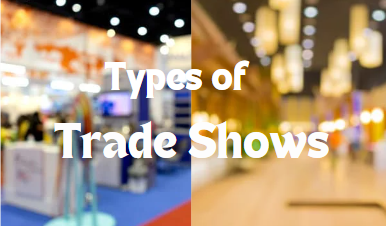
Trade shows play a big role in expanding overall business reach. Different types of trade shows are held to promote products and services, based on the industry one belongs to, the objective, and other factors. By understanding various types of trade fairs you will be able to choose one that best suits your needs and goals.
- Healthcare Industry Trade Shows: Healthcare industry trade shows are conducted by healthcare experts or companies to connect potential customers and partners. The purpose of holding healthcare fairs is to share the most recent developments in medical technology and services.
Healthcare industry events specifically target doctors, hospitals, pharmaceutical companies, researchers, nurses and medical manufacturers. - Technology Industry Trade Shows: A technology industry trade show is an event where companies in the technology sector come together to showcase the latest and innovative products or services to their target audience.
Various companies in the technology sector such as software, hardware, mobile, and others work on creating fresh products and services.
These trade shows are attended by investors, entrepreneurs, and technology professionals who are looking to buy creative products or services. - Consumer Trade Shows: A consumer trade show, also known as a consumer fair or consumer exhibition, is a type of trade show where companies showcase their latest products and services directly to consumers, i.e. the general public.
In this kind of trade exhibition, the products displayed to the public are mostly used for personal use such as home & garden, health & wellness products, electronics fashion, automobiles, and more. - Food Industry Trade Shows: Food industry trade fairs are exhibitions where food businesses and beverage sectors come together to present the latest innovations, ingredients, and equipment related to the food industry to potential buyers.
Expert cooks, chefs, and food companies join this type of trade show to learn more about the latest trends, innovations, and breakthroughs. Large industrial brands like Nestlé, Unilever, PepsiCo, and many more frequently organize food industry trade shows. - Agriculture Trade Shows: Agriculture trade fairs are events where companies in the agricultural industry, farmers, horticulturists, and ranchers gather to share innovative ideas about farming sectors.
Participants attend these trade exhibitions to discuss the latest farm machinery, farm equipment, new seeds, and other agricultural developments. - B2B (business-to-business) Fairs: B2B trade shows are specialized events where companies represent their product or services to potential business clients, distributors, partners, and suppliers.
These fairs are designed for businesses to connect with other businesses in their industry or related industries. B2B trade fairs are held locally, nationally, or internationally depending on the scope and purpose of the event. - Fashion Industry Trade Fairs: Fashion industry trade shows bring together fashion brands, wholesalers, and retailers to network and extend business relationships. Fashion trade fairs are typically organized for various aspects such as clothing, accessories, footwear, and textiles. In such types of trade fairs, suppliers show the upcoming collections and trends in fashion designs.
- Travel and Tourism Trade Fairs: Travel and tourism trade fairs focus on providing tourism-related products and services to travel companies, agencies, and enterprises.
Exhibitors at travel and tourism trade shows typically include airlines, cruise lines, hotels, resorts, destination marketing groups, tour operators, agents, and travel service providers. - Environmental Trade Shows: Environmental trade shows are events that focus on addressing environmental-related issues. The common themes of these trade fairs are sustainability, renewable energy, clean water technologies, waste management solutions, and pollution control systems.
Environmental trade fairs help educate attendees about environmental protection, climate change, and the importance of adopting eco-friendly solutions.
What are virtual trade show booths, and why are they important?
Just like their physical trade show counterpart, virtual trade show booths are used to introduce attendees to companies and their products and share information about them. Crucial features are branded displays, the ability to have demos and one-on-one or group discussions, and easily downloadable PDFs, brochures, and other marketing collateral. .
Since the purpose of a trade show is to let companies feature their products, booths are an essential part that gives them the space to do so.
Are virtual trade shows worth it?
An immersive virtual trade show is absolutely worth it. Not only can exhibitors set up from anywhere, but it also makes it easier for people to attend—especially if travel or lodging are a challenge.
Other advantages of a virtual trade fair are:
- The potential for increased attendance with an expanded global reach.
- Saves time and money for hosts, exhibitors, and attendees: Online trade shows are far more cost-effective.
- The right virtual event platforms let you track data more effectively and integrate with your business’s tech stacks. It helps event organizers make smart data-driven decisions that maximize engagement.
- Virtual trade shows are more eco-friendly.
- Attendees can access virtual booths, exhibits, and information for longer.
How to host a successful virtual trade show
A successful virtual trade show begins with goals and objectives that center around the attendee experience. Ask yourself, do I know how to create a virtual trade fair that engages? And how do I host a virtual trade show that lets exhibitors provide the information attendees want while also allowing them to feature their brand?
As you get started, you may wonder—how does a virtual trade fair work? In essence, they’re much like in-person trade shows. However, they require slightly different tools and skills.
Whether this is your first virtual trade show or your fiftieth, all you need to do is take these actions to ensure that your virtual trade show is a hit.
Create an attendee-centric experience
It all begins with a question: What do attendees want from a trade show?
The top responses typically include industry insights, competitive knowledge, the best products and deals in the industry, the potential to form business partnerships, and networking opportunities.
Now the question becomes: How do we create an attendee-centric experience? The answer is that you must make all content, the agenda, any speakers, and the brands that you partner with revolve around a great attendee experience. If attendees are engaged, you and your sponsors will get the most out of your trade show.
A great place to start is to create a value proposition — in other words, the unique value your event will offer attendees. Think of this document as a roadmap that outlines the promises you’re making. Each should spell out how your event will benefit and the provisions you need to facilitate those benefits.
Look for trade show partners, exhibitors, and sponsors
Trade show partners, exhibitors, and sponsors are key ingredients to a successful event. You’ll need to know where to look to find the best fit.
Partners
You need to find a trade show partner you trust. These partners are companies that join event organizers to co-create or co-organize a trade show. They should be able to help you plan, strategize, organize, and execute the events. Before looking for a partner, identify your needs, expectations, goals, and potential challenges. You’ll also need to clearly evaluate how involved you want your partner to be before approaching them.
From there, look for potential partners and do some background research on them. Select those that fit, and set up a way to meet with them so you can settle on the right one.
Exhibitors
Virtual trade show exhibitors want the same thing you do. They want to drum up awareness about their brand, generate leads, and create excitement around a product or service. You’ll need to offer them value and make your virtual trade show worth the investment, and that makes them feel like they’ll attract numerous booth visitors.
To connect with potential exhibitors, use:
- Content
- Social media
- Emails
- Your network
Provide them with transparent information about the trade show and show them how you’ll give them a valuable and seamless exhibitor experience.
Sponsors
Use some of the same tactics mentioned above to find sponsors, but also research who has sponsored similar events.
To make sponsorship more enticing, make sure to offer all the details and offer different budget options. To find optimal sponsors, make sure you are targeting companies that reflect your event values.
Think about ways to offer the most value to your partners, vendors, exhibitors, and sponsors
The value that your partners get out of the trade show depends on the capabilities of your virtual event platform.
You need a platform that lets you set up virtual booths for your exhibitors—and lets exhibitors brand their booths. Virtual exhibit booths should have features like interactive live demos and presentations, ability to engage prospects in live one-on-one or group meetings, downloadable resources, and should be able to capture attendee data for deeper insights.
Additionally, the more interactivity and engagement opportunities you give your partners, vendors, exhibitors, and sponsors, the more valuable their experience will be.
Empower networking at your event
Networking opportunities should be a core feature of your virtual trade show. This will bring in the most value for your exhibitors, sponsors, and attendees.
Use a platform that provides breakout sessions, virtual social lounges, speed networking, a virtual exhibit hall, and features like Fluid Space.
Find speakers and industry leaders for keynotes
Hosting keynotes will help you attract attendees to your trade show. Speakers should:
- Fit your budget
- Be experts in the field, providing thought leadership and a dynamic perspective
- Engage and entertain
- Meet your attendees’ expectations
- Align with your event values and goals
- Have energy that engages and inspires the audience
Build teams to execute different tasks and distribute responsibilities
When looking at how to host a virtual trade show, realize that it takes a team. Going it alone can make the experience overwhelming and challenging.
Like any other event or project, you’ll want to delegate. Create an in-depth roadmap that includes pre-planning, execution, and post-event tasks. Distribute responsibilities to people or teams with the skills to fulfill them. Examples of tasks you can create are:
- Ensuring support for exhibitors
- Onboarding speakers
- Managing vendors
- Scheduling the gifts
- Creating branding and content for the event
- Posting social media
- Finding partners to promote your event
Promote your trade show to gain signups
The better your promotions strategy, the more you’ll drive signups. Learning how to promote an event is important. To get started:
- Understand your audience and know where to reach them
- Use multiple channels to promote: Emails, host committees, website landing pages, your network, newsletters, social media, and cold prospecting platforms
- Design enticing content
- Create a schedule for distributing your trade show’s information
Create a strategy to measure ROI
Tracking your event efforts lets you know where you’re successful and where you still need to improve. Determine some KPIs and a strategy that lets you accurately measure your ROI, whether it’s related to time or budget efforts.
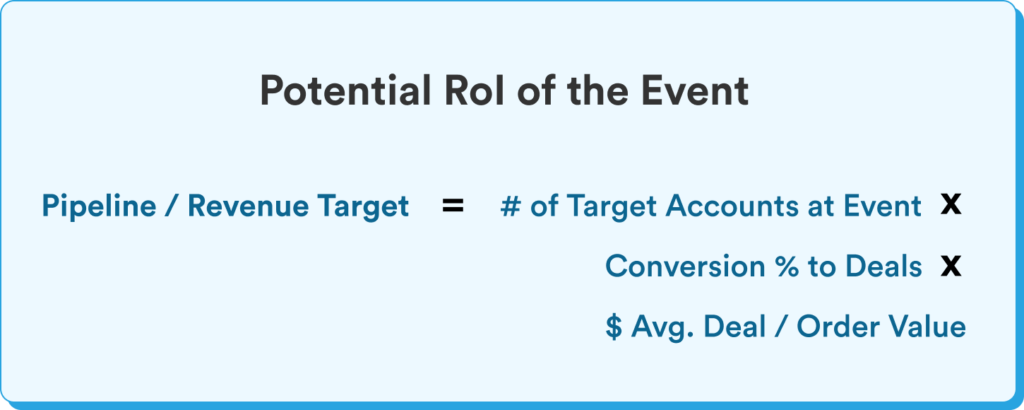
How to Do Marketing of a Virtual Trade Show?
Promotion of trade show events is essential to inform exhibitors, attendees, and sponsors about the event. If you are seeking ways to market and advertise your virtual trade expo, consider these below trade show promotional ideas.
“Good Marketing Makes the Company Look Smart. Great Marketing Makes the Company Customer Feel Smart.” – Joe Chernow
- Create a Landing Page: Creating a landing page for your virtual trade show event is a key step in grabbing audience attention and driving trade fair registration. In order to effectively convey your brand message to your intended audience, it is important to create a branded landing page of the virtual trade show, with all key event details.
A well-designed landing page will leave a strong and lasting impression on your target audience, which can lead to greater registration and attendance rates. Additional information on the landing page, such as company history, speaker bios, and social media buttons will let attendees learn more about the trade exhibition event.
- Invest in Organic Promotions On Social Media: Social media is one of the most powerful communication channels today when it comes to marketing. It is a great way to create a buzz about your event among your followers and build strong connections with your present and future clients by actively engaging with them.
Create high-quality, engaging content around your virtual trade fair using multiple formats like videos, images, and infographics. Share these posts on different social media platforms like Facebook, Instagram, and LinkedIn. Actively engage with them by responding to their comments and messages. This will improve your organic reach.
Organic marketing strategies are not only more budget-friendly but will also assist your audience in learning about your company’s brand story, which leads to increased trust and brand loyalty.
- Invest in Paid Promotions: Running paid ads is one of the most effective marketing options as it allows you to reach a wider audience than organic promotional strategies tend to. Utilize social media platforms like LinkedIn, Facebook, Instagram, and Twitter to promote your virtual trade show events.
Create compelling ad copy and visuals. Ensure the ad content is clear, concise, and appealing. Paid promotions help drive more traffic to the event landing page and increase its visibility among targeted audiences.
- Launch an Email Marketing Campaign: According to research,87% of brands say that email marketing is critical to business success. Email marketing is still one of the top promotional channels, which you must tap into, as part of your virtual trade show marketing strategy.
Begin your email outreach campaign by creating eye-catching email templates that include engaging headlines, attractive graphics, tempting offers, and other important event-related details. Segment your email list and send invitation emails with CTA leading them to the registration page.
Following that, analyze key metrics of your email campaigns, such as open rates, click-through rates, and conversions. It will help adjust your email marketing strategy accordingly.
- Collaborate with Influencers: Social media influencers have changed consumer behavior and patterns and transformed the business landscape with their huge followings. They can play a big role in promoting your virtual trade fair if executed well. Partnering with the right influencers enables you to increase your trade show’s reach to your core market. Identify influencers based on your niche, then reach out to them and express your interest in collaborating. Make sure the influencer you choose fits your budget and marketing goals.
- Leverage Traditional Marketing: Even though your virtual trade show will take place online, you can still invest in traditional marketing. They are just as effective today, as they were in the pre-internet era. Advertise your trade fair details in print media (newspapers, magazines, and brochures), TV ads, and more.
Add QR codes to your print materials that will link directly to the landing page to drive registration. Additionally, send direct mail like letters or postcards to increase local participation and registration.
Key Features Your Virtual Trade Show Events Must Have
Investing in the right event technology software is the key to the success of your virtual trade show. To accomplish this, it is essential to ensure that the virtual event platform has all the key features that enhance interaction, foster engagement, and facilitate networking among attendees and exhibitors. Here are some must-have features that your virtual event platform should offer for you to successfully execute your virtual trade show exhibition.
- Appealing Virtual Exhibitor Booths: Virtual exhibitor booths are an important aspect of any online trade fair exhibition. This is where attendees come to learn about the company’s products or services. Virtual expo rooms provide a virtual space where booth staff display their product and service details to visitors. The virtual exhibit hall is crucial to replicate the experience of a physical trade show.
- Sponsor and Exhibitor Lists: Make a list of sponsors and exhibitors within your trade fair. This will help attendees find interested company’s booths and explore their products or services. By offering a list of sponsors and exhibitors, you can simplify and improve your attendees’ virtual trade show experience.
- Customized Branding Features: Branding and customization features allow you to create a unique brand voice and extensive online presence. Trade fair software should include interactive 3D virtual setups, custom backgrounds, logos, colors, videos, and more to make virtual booths look impressive and remarkable.
- Live Chat and Networking Features: Your virtual trade show platform should have a live video chat option to connect and engage with attendees in real-time. The chat feature helps promote direct communication among participants, exhibitors, and sponsors in a virtual environment.
Additionally, trade show technology must have networking capabilities such as virtual meeting rooms and interactive online forums to let attendees make new connections, just as they would at a traditional trade fair.
- Lead Capture Tools: A virtual trade show platform should provide exhibitors with tools or forms to capture the number of leads. Lead capture form will help collect the contact information of potential attendees. Also, they enable exhibitors to connect with potential customers for follow-up communications. Lead-capturing apps will help you speed up your lead management operations.
7 Virtual trade shows ideas to boost engagement at event and booths
If your virtual trade show ideas are innovative, you’ll see a boost in engagement. Here are 7 you can start with:
1. Spin the wheel
Prize stalls at events are always a big customer magnet. Your booth exhibitors can arrange Spin the Wheel contests to attract more customers and sprinkle some fun!
2. Virtual Photo Booth
Virtual photo booths are the perfect solution to boost attendee engagement and increase reach. Your customers stay engaged clicking selfies in the photo booth, and you get additional reach when your attendees create content, and share the experience with the world.
3. Provide sign-up swag
One thing virtual trade shows often lack is the swag you get at an in-person event. Encourage sign-ups by offering a swag bonus. After they register, send them swag from sponsors—like t-shirts, mugs, and pens—and let them promote brand awareness when they use it during your virtual trade show event.
4. Maximize networking with competitions and prizes
Get attendees involved with a trade show idea that sparks friendly competition and optimizes networking. Have attendees track their number of connections (with exhibitors, other attendees, speakers) within a specific time frame, and whoever has the most will win a prize from one of your sponsors.
5. Give discount codes for attending sessions
Another great trade show idea that increases attendance to sessions is offering product discounts from different exhibitors.
6. Provide exhibitors an engagement checklist
Give your exhibitors a cheat sheet on dynamic ways to engage and facilitate interactions and ways to capture attendees’ attention. You can even offer a platform training webinar that shows them how to utilize all the features. This not only helps your event but is also one of those virtual trade show ideas that makes you a standout trade show host.
7. Use a platform that’s highly customizable and loaded with engaging features
Grab your attendees’ attention visually. Instead of a bland look and feel, make it easy for them to identify each unique exhibitor and vendor. Exhibitors can take the customization one step further by creating a unique experience from other virtual exhibit booths with presentations, networking opportunities, and more.
Key Benefits of Virtual Trade Shows
Virtual trade shows provide a great opportunity for businesses to showcase their product and service offerings in a digital format. Online meetings take place on virtual events platforms which provide an engaging and interactive online event experience. Today, businesses around the globe have tapped into the power of virtual events platforms to connect with their potential customers and expand their business. From agriculture to technology, healthcare to food, every industry can benefit from organizing online trade shows.
Let’s take a look at the key benefits of virtual trade shows:
- Cost Saving: Virtual trade shows are so much more affordable than traditional, physical events. Organizing an in-person trade show requires you to spend a lot of money on venue rentals, travel, accommodation, booth setup, catering services, and more associated with a physical trade show. Virtual trade shows do not require you to invest in any of these typical expenses. This will save companies a ton of money and also provide huge benefits to businesses of all sizes.
- Global Reach: Digital events are not geographically limited to people belonging to a particular area. They have the potential to attract people from all around the world, allowing you to connect with a much larger and global audience than traditional trade shows. If you want to broaden your trade fair events reach, a virtual event is the best way to do so.
Virtual trade shows allow you to connect with potential customers and partners in new markets, which is also not possible with a traditional event. - Longer Lifespan: Unlike traditional events, virtual trade shows typically tend to have a longer shelf-life. Physical trade shows usually last for a few days and then end. However, with virtual trade shows, the recordings of the show can be accessed and used even after the online event is over. They have a much longer lifespan.
One of the biggest advantages of a virtual trade show is that you can upload the footage of your online trade fair online to enable audiences to view it whenever they need to. If someone from your intended demographic was unable to attend the live event for any reason, they can still benefit from the recordings.
Additionally, you can repurpose the content of your digital trade show into social media posts, blog posts, and podcasts. This ensures that the exhibition content is still usable for generating leads and engagement even after the actual event ends. - Sustainable & Flexible: Virtual trade shows are sustainable as they eliminate the use of paper, plastic banners, and so many other physical materials. It also makes a more eco-friendly option compared to traditional trade shows because you eliminate the need to invest in electricity, water, travel arrangements, and so many other requirements.
Internet trade shows also offer flexibility in terms of scheduling the event. Interested attendees can visit virtual trade show booths and access the event at their convenience. Also, exhibitors can engage with potential buyers at any point during the event - Data Tracking and Lead Generation: Virtual trade shows track valuable data and provide detailed analytics on attendees that traditional trade shows simply cannot offer. You can monitor your participant’s actions, like the products or services they viewed, for how long they stayed at the booth, how many times they visited the exhibit stand, and more.
Having a larger attendee pool helps you generate more potential leads. Virtual trade fair software has integrated CRM tools like HubSpot, Salesforce, and Zoho to capture and manage leads effectively in real-time. This integration ensures that valuable lead is not lost and can be leveraged for future marketing efforts. - Networking: Virtual trade shows often offer their audience educational webinars, conferences, and workshops along with product demos. They also provide attendees with opportunities to network with other professionals.
Many virtual trade show platforms offer networking features like speed networking, live chat rooms, and virtual lobbies to interact and connect with others. Similar to in-person events, attendees can interact on a live chat and engage with others virtually.
How Do Sponsors Benefit From a Virtual Trade Show?
The biggest benefit sponsors gain from virtual trade shows is that their brand visibility reaches new audiences. Virtual events typically include global participants, broadening the brand’s reach beyond localized audiences.
Plus, sponsors get flexibility on sponsorship options. They can choose from tiered sponsorship packages tailored by organizers to meet their varying budgets and marketing goals. These packages include banner add-ons on virtual booths, prominent logo placements across the entire virtual event platform, and more.
Furthermore, virtual trade shows provide sponsors with detailed analytics, allowing them to track the effectiveness of their sponsorship investments and measure the return on investment (ROI). In addition, sponsors can host webinars, participate in panel discussions, and directly engage with potential audiences.
How Does a Virtual Trade Show Different From an In-person Trade Show?
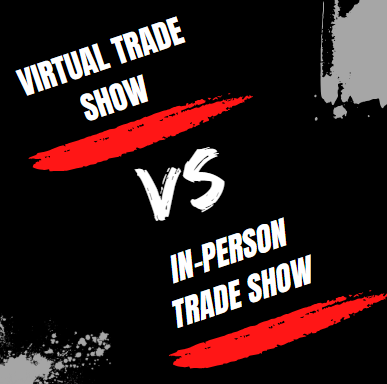
Sr. No | Virtual Trade Show | In-person Trade Show |
1 | Virtual trade shows take place entirely online, with digital booths, and digital content | Physical trade shows involve physical booths and physical product displays |
2 | Virtual shows can be attended by attendees from all over the world. | In-person events are limited to geographical locations and require traveling to a specific venue |
3 | Virtual shows cost less than in-person ones, making them more budget-friendly | Physical events have high costs for venue rental, booth setup, travel, logistics, and more |
4 | Interactions with an audience take place through a video chat, virtual booth, and messaging | Face-to-face physical interaction with potential customers |
5 | Through social longue and breakout rooms, attendees can network with others | It allows attendees live networking opportunities right on the spot |
6 | Less environmental impact such as no travel and no waste generation | Increased environmental impact due to increased travel, waste of booth materials, and energy use |
Virtual trade show best practices
Put a few best practices in play to get the most from your virtual trade show.
Clearly position your trade show
Clearly state your trade show’s industry category and content to attract the right sponsors, exhibitors, and attendees.

Promote your event with a multichannel approach
Find people where they’re at to increase attention by using a multichannel marketing and promotion approach.
Provide a variety of content and downloadables at your virtual trade show
Have sessions, speakers, exhibitors, vendors, lounges, and other content that widens the appeal and keeps booth visitors interested. Encourage your exhibitors to offer a variety of content as well, from videos to 1-to-1 breakout sessions.
Follow up after your event
Reach out via email, survey, social media, and other avenues to find out about the overall trade show experience. Use it to discover your strengths and areas you can still improve.
How to choose the right virtual trade show platform for your event?
The best virtual trade show platforms have one thing in common: Numerous features to connect and engage attendees.
Before selecting, look at the different virtual trade show platforms and their capabilities. Then ask yourself questions like:
- Do booth exhibitors get their own stage, lounges, and networking features?
- Can the booths be branded, and can they hand over digital marketing collaterals like brochures?
- How can the platform empower you to create engaging and exhilarating experiences?
- What does the stability of the platform look like?
Virtual event engagement, networking, and capabilities of booths are the key component to success of an immersive virtual trade show, and the more interactive and customizable the booths are, the more value everyone gets.
You can assess the best virtual trade show software and best virtual trade show platforms by looking at:
- Capabilities of booths like branding, and attendee engagement.
- Networking features like social lounges, speed networking, one-on-one meetings, rich attendee profiles, and Fluid Spaces.
- Engagement features like q&a, chats, interactive demos, gamification, and 3rd party integrations like Snapbar.
- Analytics for real-time prospecting
- ROI and event performance insights
- Ability to measure event and individual booth performance
- Integrations
- Event support (and is it 24/7)
As an example, explore virtual trade show platforms to see if they have booth features like built-in social lounges, 1:1 meeting bookings, and an interactive stage (for demo presentations and keeping retaining attention). Look to see if exhibitors can distribute marketing collaterals like brochures and CTAs that direct to their website.
The central goal should be finding the right virtual event platform that puts the attendee experience first.
What are the best virtual trade show platforms?
There are many virtual trade show platforms out there—but which is the best? Here are the top 6 to consider:
Airmeet
Airmeet has made it a goal to make virtual events more human-centric. They have seized every opportunity to develop features that create standout experiences. G2 reviewers found it easy to use and incredibly realistic. One challenge for users was hybrid events. Some of the top features were:
- 3D lobby.
- Customizable reception.
- Business card exchange
- Stellar engagement features like leaderboards, Q&A, interactive stages, and networking spaces inside booths. Attendees can engage in chat and react with emojis.
- Iframe integrations to make events more interesting, for example, a Snapbar integration that supports selfie booths.
- Superior booth experience.
- Event and booth branding with AirStudio.
- AX360 to help attendees network and connect in meaningful ways.
- Spaces and features for attendees to connect like Fluid Space, Breakout rooms, speed networking, chats, and Social lounges.
- AirIntel to measure event performance and get highly granular reports.
- Aircontrol to manage multiple workflows.
- 24/7 support.
Airmeet’s extensive features earned several G2 badges this past fall, including Best Usability (Mid-Market), Best Relationship (Mid-Market), Users Most Likely To Recommend (Mid-Market), Best Results (Fall), Leader (Fall).
Hopin
Hopin is an all-in-one platform that’s scalable and designed to closely replicate an in-person event. Hosts find it user-friendly. However, some reviewers on G2 found limitations unless things were set up correctly, which for some people, took time. Some standout features include:
- Live video.
- Numerous event areas, including reception, stage, sessions, and more.
- Networking features.
- Event support
- Customizable registration.
Vfairs
People mention Vfairs step-by-step design wizard as an appealing feature of the platform. But some users that reviewed the platform on G2 said that although support was top-notch, they weren’t quite sure where their money went—in other words the product didn’t meet expectations given the budget. The top listed features for Vfairs are:
- Optimal mobile event application.
- Matchmaking and chat tools.
- 3D spaces.
- Customizable virtual booths and trade show spaces
Dreamcast
Dream cast offers plenty of virtual event tech to create online trade shows. In general, people who reviewed Dreamcast on G2 found the immersive experience excellent, although some attendees were daunted by navigating between sessions. Dreamcast did have solid backend support for attendees, and some of their best features include:
- AI matchmaking.
- Event analytics and support.
- Immersive 360-degree venue.
- Live polls and Q&A.
- Business card exchange feature.
HexaFair
HexaFair’s platform aims to deliver unique experiences. Users felt the platform helped increase their conversions and optimized brand visibility. But a G2 user said that it lacked integrations. Overall, some of HexaFairs most notable features were:
- Ability to replicate an in-person layout virtually.
- Draws audiences from around the globe.
- Business card exchange for more post-event connections.
- 3D avatars.
Samaaro
Samaaro is a virtual event platform that creates 3D virtual trade shows that also foster connections. Samaaro is seen as user-friendly and intuitive. However, reviewers on G2 found the chat feature confusing at first. Standout features included:
- End-to-end event solutions
- Networking features
- Sponsor management features
- Registration and analytics dashboard
- Customizable event landing page
6Connex
6Connex sees itself as a virtual trade show platform that provides an immersive experience. People who use the platform loved the live support feature and user interface. On the other side, some G2 platform reviewers mentioned it lacked the streamlined experience of other platforms. The top features listed are:
- A good UI.
- Available virtual venue templates.
- Customizable virtual spaces.
- Branded booth experiences.
The best virtual trade shows are designed to give attendees industry insights, access to product deals, networking opportunities, and competitive knowledge. They also provide value for exhibitors and sponsors. Put this guide into action using Airmeet as your online trade show platform to create an event that lets everyone walk away with a win.
FAQ
Among the various platforms out there today, Airmeet offers a cost-effective plan. Their 10-day free plan allows you to host a trade show with up to 25 attendees per event which is ideal for small online trade shows with limited exhibitors and attendees. A free plan is a great solution for businesses to familiarize themselves with the virtual tradeshow platform. Airmeet also offers paid plans starting at $199 where you can host unlimited trade show events with up to 100,000 attendees.
You can use several common strategies to boost your leads such as designing an eye-catching booth, adding interactive games, engaging with audiences with interactive features like Q&A, live chat & polls, and showing live demos of products or services. Additionally, you can run a contest to attract visitors to your booth and collect their contact information. These strategies will make your booth memorable and without a doubt assist you in skyrocketing your leads at virtual exhibitions.
Virtual trade exhibitions are held entirely online in a digital setting, allowing global participants to join from any location. On the other hand, in-person trade shows take place in a physical setting where attendees have to travel and attend a trade show by going to the event location.
Airmeet is one of the best and most reliable virtual trade show platforms that allows companies to set up premium virtual booths to enhance their effectiveness. Exhibitors can customize their booths with the virtual platform’s high branding features such as 3D effects, background images, graphics, and videos. By hosting your online trade show event on Airmeet, you can give your attendees an amazing virtual trade fair experience.
In 2024, we can expect to see a focus on creating virtual events more engaging to provide immense experience to attendees, including
- Use of Artificial Intelligence (AI): Artificial Intelligence (AI) will take virtual trade shows to the next level and it will be used more frequently to personalize interactions with attendees.
- Augmented reality (AR) & virtual reality (VR): Augmented reality (AR) and VR technology will greatly improve the virtual trade fair experience in the future.
- Hybrid and Virtual Experiences: Hybrid programs, combining in-person and virtual components will become increasingly popular. Many virtual trade shows will likely be held using a hybrid model.
- Enhanced Analytics and Reporting: Virtual trade fair platforms will offer robust analytics capabilities to gather accurate data on attendee engagement.
To measure the success of virtual trade shows, you will need to analyze key metrics and key performance indicators (KPIs). They will provide detailed insights into the effectiveness of your online trade show. Key indicators include participant registration, booth traffic, and attendee engagement, while in KPIs, you will have to track leads, conversion rate, and revenue generated.
As an exhibitor, you should create high-quality content such as infographics, videos, interactive live demos, and downloadable resources. Also, an engaging visual booth should be created with clear branding. Plan how you will capture leads through chat and Q&A sessions. Make sure employees are well-versed with a virtual event platform to better interact with attendees. Last but not least, have a strong pre-event marketing plan to drive traffic to your virtual booth.
You can generate leads by directly asking attendees to share their contact details. Plus, you can hold workshops or seminars and offer downloadable guides, or templates in exchange for their contact. Along with that, include games or competitions to encourage participation and attract potential leads.



